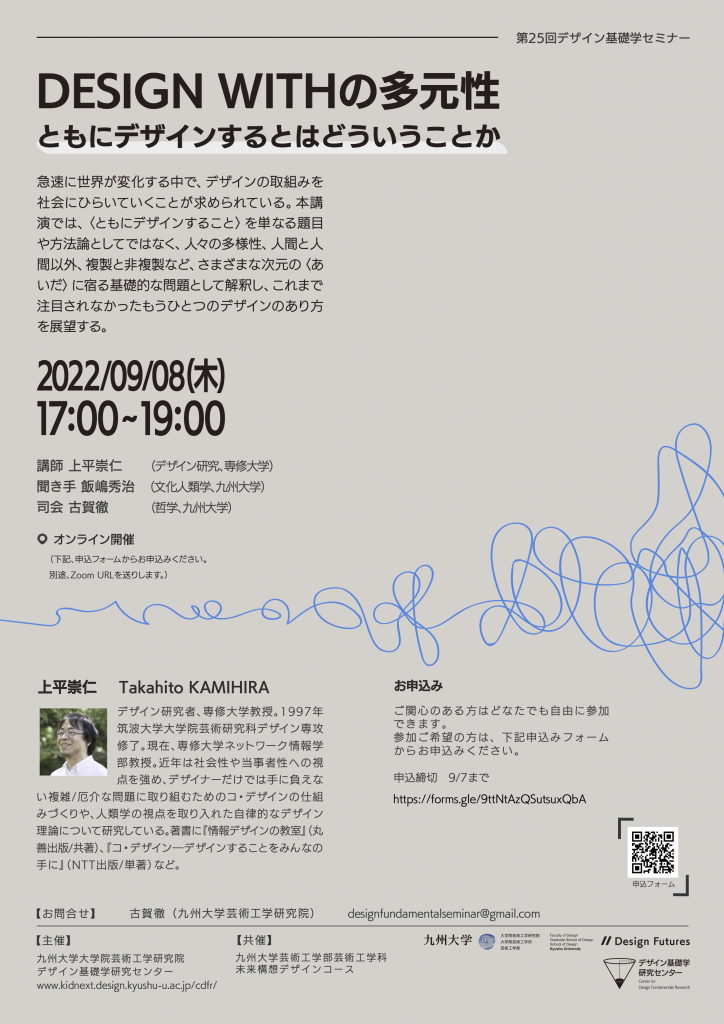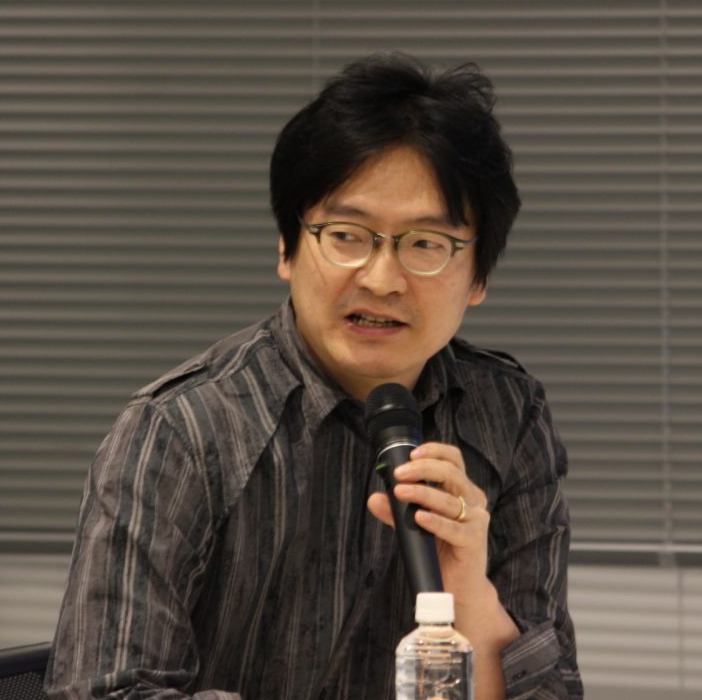The 25th Design Fundamentals Seminar “The Multiplicity of “DESIGN WITH”: What It Means to Design Together”
In a rapidly changing world, there is a need to open design initiatives to society. In this lecture, we will interpret “DESIGN WITH” not as a mere title or methodology, but as a fundamental issue that lies AMONG various dimensions, such as the diversity of people, humans and non-humans, and reproduction and non-reproduction, and look forward to another way of design that has not received attention up to now.
Lecturer
Takahito KAMIHIRA (Professor of Senshu Univ.)
Design researcher and professor at Senshu University, born in 1972 in Akune City, Kagoshima Prefecture, completed the Graduate School of Art and Design, University of Tsukuba in 1997. After working as a graphic designer, assistant at Tokyo Polytechnic University, and visiting researcher at Copenhagen IT University’s Interaction Design Research Group, he is currently a professor at Senshu University’s School of Network and Information. He has been involved in research and practice of information design since its pioneering period in 2000, and is active as a leader in the field of information education. In recent years, focusing more on the social aspects of design, he has been researching the creation of co-design mechanisms to tackle complex and wicked problems that cannot be handled by designers alone, and autonomous design theories that incorporate the perspectives of anthropology. He is a member of the Information Design Research Group of the Japanese Society for the Science of Design (JSSD). Invited researcher at Ethnography Lab, Osaka University. Design partner of ACTANT Co. His publications include “Jyohou Dezain no Kyoshitsu” (Maruzen Publishing Co., Ltd., 2010) and “Co-Design: Dezain surukotowo Minna no Teni” (NTT Publishing Co., Ltd., 2020).
Facilitator: Shuji Iijima (Kyushu Univ.)
Host: Toru Koga (Kyushu Univ.)
Date
Sep 8th, 2022: Opens at 16:50 p.m, Seminar starts at 17:00 p.m. JST.
Venue
Online

Review
The Range of Design Multiplicity
Even after the end of industrial era, Kamihira says, the design process has been dominated by a one-way, stand-alone relationship, wherein designer products are massively reproduced, and people use them. In contrast, “co-design” refers to the design process wherein people are as involved as designers; alternately, the people are “DESIGNING WITH” designers.
I have, however, noticed that the users’ and residents’ participation in design is not a new idea, as it was institutionalized to a certain extent, in the 1990s, in the form of citizen-participatory design, at least as a pretense. Dr. Kamihira here responds to such questions politely.
According to Dr. Kamihira, co-design originated as participatory design in Scandinavia. Until now, designers on the management side designed the production line and the way labor should be; and labor, as “designed things,” had no choice but to follow the design. In contrast, in Nordic social democracies, workers and employers have a tradition of “designing together” at one table, rather than confronting each other by force, in terms of working conditions and work methods.
In this tradition, human beings are both “designing” and “designed”. And today, nature and materials are not only “designed” by humans, but are now also “designing” humans. The whole world participates in this single exercise. Dr. Kamihira asserts that it is thus, necessary to view design as if it were the Buddhist world of karma.
What does it mean for nature and materials to be the subject of design? The key here is the viewpoint that the subject of design is not an individual person or a thing, but rather the “relationship” between a human being and something. For example, let us say that I have changed my approach to the trees in my garden. Or I will change my attitude toward the stray cats that visit my yard. This new relationship will surely have a ripple effect. As long as this new attitude toward the world can be realized only with trees and cats, these “things” also play active role of design, to that extent. It is not surprising that when a designer creates a product, they are also created by the materials they work with. The designer is not so much the creator of the product as a catalyst for diverse relationships.
If buildings and products are thus, born as nodes of various relationships, then they will not be subordinated to a single meaning (function) given by a designer. In the case, as introduced by Dr. Kamihira, of the architecture of a Copenhagen elementary school, where children can slide down from the roof on a spiral slide, the architects did not merely incorporate the children’s voices. It also showcased the architects’ skill in giving form to these outlandish voices, the courage of the administrators in advocating the seemingly dangerous playful spirit, the declaration of the town’s ideal of aspiring to live in this manner with their children, and the residents’ pride in living in such a wonderful town. All these lead to a single product that has multiple meanings and functions, in multiple contexts.
In retrospect, these are unforeseen functions that had already been created beyond the original intention of the planners. The success or failure of the design will then be evaluated, not only by the degree to which the original intention was realized, but also that by which it produced abundant unintended effects, and to which it created room for mobility, or the possibility of freedom, in the given situation. In simple terms, I feel that this mobility can be expressed as “enjoyment” of being shaken by the design.
The phrase “DESIGN WITH” has such a wonderful meaning that it will change the way we look at the world. If we dig into the roots of the residents’ workshop and participatory design, which are merely excuses, we find a wealth of nourishment hidden there.
(KOGA Toru)


